Firecrest (Regulus ignicapilla)
(1) Where, when and how many?
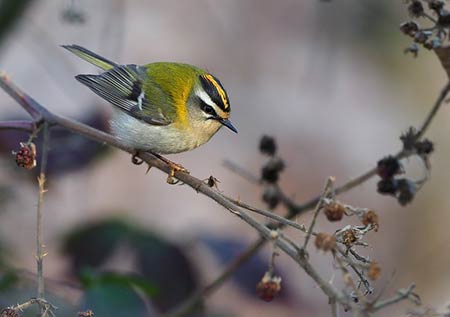
© Frank Vassen / Attribution 2.0 Generic (CC BY 2.0)
The Hampshire Bird Atlas (2009 - 2012) shows Firecrests breeding in virtually all parts of the New Forest's Crown Lands - the area managed by the Forestry Commission, as was, now Forestry England - where significant amounts of woodland are present.
However, the areas around Bolderwood and Rhinefield have historically been viewed as 'the' places to see Firecrests in the breeding season, whilst in relatively recent years the population has expanded into parks, gardens and other areas of private land within the wider New Forest National Park and adjacent areas.
When: Firecrests are typically present in the New Forest all-the-year-round, although outside the breeding season, from late June and early July, many - apparently especially females and juveniles - wander widely, frequently tagging along with roving bands of tits and sometimes moving well out of the area.
Harsh winter weather probably encourages further movements amongst any that remain.
How many: Firecrests are relatively widespread within the New Forest, particularly as a breeding bird, but despite this relative abundance, many bird enthusiasts consider it a red letter day when prolonged views are obtained.
(2) A wildlife success story
The Firecrest represents a huge wildlife success story, a story largely crafted by nature rather than resulting from the work of conservationists, although without the efforts of dedicated ornithologists, the tale could not be told - Mike Adams in the first instance discovered Firecrests breeding in the New Forest, whilst Mike, Marcus Ward, Russell Wyn and latterly Rob Clements have since extensively monitored the fortunes of this attractive bird.
Anyway, way back in the mid-20th century the New Forest was, and to some extent still is, towards the north-western edge of the Firecrest's breeding range. The species then was more associated with the warmer parts of mainland Europe, but during the first half of that century, and subsequently, its range expanded, primarily to the north and west.
In the UK until the early 1960s, Firecrests were known only as regular spring and autumn migrants in very small numbers, primarily at coastal locations. But during the 1961 breeding season, the species was recorded at Bolderwood in the New Forest - four birds in total, including three singing males - and in 1962, six singing males were observed and fledged young were later seen being fed, thereby establishing proof of breeding.
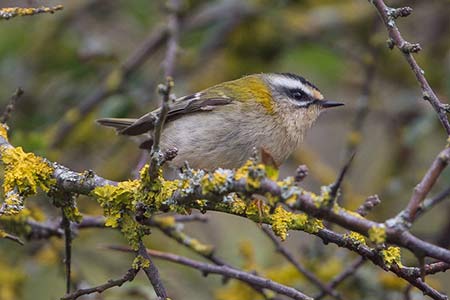
© Ron Knight / Attribution 2.0 Generic (CC BY 2.0)
Subsequently, in 1972 Edwin Cohen and John Taverner (A Revised List of Hampshire and Isle of Wight Birds) noted that 'a few pairs have nested since at least 1962 and there are occasional reports of birds in winter' although, in fact, in the period to 1972, up to 27 territories were discovered each year in the New Forest.
The Firecrest population during the breeding season has since increased considerably and the birds have colonised many new areas within the New Forest, within the county and farther afield, although the Crown Lands continue to hold a significant proportion of both the Hampshire and national populations. Indeed, it could be said that the Firecrest is still something of a New Forest 'speciality' bird.
The upward trend in recent years has been particularly marked, with 165 territories recorded on the Crown Lands in 2009, 266 in 2011 and 531 in 2014, whilst in 2016 a massive 602 territories were recorded, part of an estimated New Forest population at that time of 1,400 pairs, which includes an estimate of the number of Firecrests present in woodland on private land, in large gardens and elsewhere within the New Forest perambulation.
A significant proportion of the recorded increases undoubtedly reflect increased observer effort, including rigorously conducted breeding season surveys in some recent years, but the New Forest Firecrest population has clearly increased considerably since that 1962 discovery, maybe in part as a result of behavioural changes within the birds' population and probably also following the more frequent occurrence of milder winters.
(Firecrests are tiny birds that are highly likely to be susceptible to harsh winter weather in much the same way as other small birds - such as goldcrests, wrens, long-tailed tits and Dartford warblers - whilst, unless special efforts are made, under-recording is also likely, again due to the birds' small size and also to their tree top habits and, for some observers, its 'difficult to hear' song).
(For lots more information about the status of the Firecrest in the New Forest, please refer to papers included in the Hampshire Bird Reports of 2009 (John Eyre), 2012 (Marcus Ward and Russell Wynn) and 2016 (Rob Clements, Marcus Ward and Russell Wynn), all of which were used in the preparation of the brief summary produced here).
(3) Description
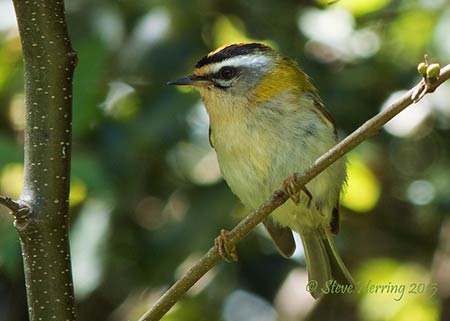
© Steve Herring / Attribution-NoDerivs 2.0 Generic (CC BY-ND 2.0)
Firecrests, together with closely related goldcrests, are the UK's smallest birds. They are tiny creatures that are slightly smaller even than a wren. Consequently, they can be difficult to see as they move about high in the branches of their favoured conifers, searching for spiders, aphids and other invertebrates on which to feed, or even when lower down in a deciduous tree that is fully in leaf.
A clear view in good light, however, will reveal a reasonably colourful bird, a mixture of quite bright greens, whites and blacks with on the crown, yellow and orange in the male, and in the female, mainly yellow with maybe a hint of orange. But the absolutely distinctive features are the Firecrest's black eye-stripe and broad white supercilium - the white stripe above the eye - features that at a glance separate it from the goldcrest.
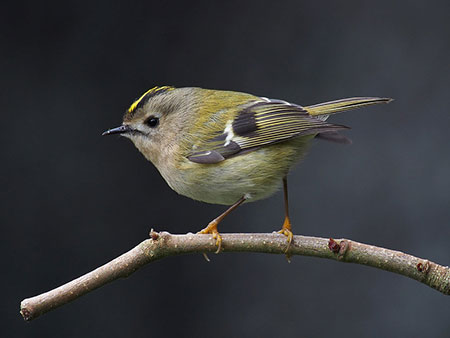
© F.C. Franklin / Attribution-ShareAlike 2.0 Generic (CC BY-SA 2.0)
The bird's presence is most often betrayed by its calls and the male's song, which, as is often the case, are difficult to accurately describe. The call is, however, described in the Collins Bird Guide as 'zuu zu-zi-zi, uttered at a slightly lower pitch than that of the goldcrest'; whilst the song is 'a repetition of the same fine, high-pitched note, slightly rising in pitch initially and in strength, and ending in a brief trill; it lacks the cyclic rhythm of the goldcrest's song'.
However, the best advice is to at the very least supplement the written descriptions with the many excellent sound recordings available, including on free-to-use Smartphone apps.
But a word of warning: the Firecrest for some is one of those infuriating birds whose calls and song are so high pitched that they are often beyond the hearing range of many seniors, myself included. And of course, those so afflicted will not know what they can't hear unless accompanied by somebody who can hear, and points out what is being missed!
(4) Breeding season
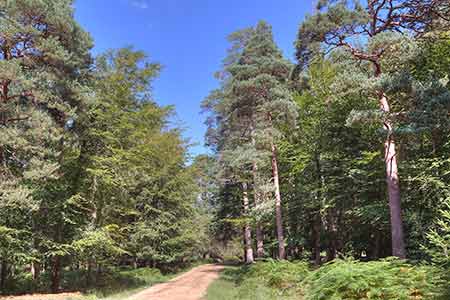
Nests are intricate constructions typically suspended in twigs near the end of a 'soft' conifer branch, or in twigs or leaves of deciduous trees or associated ivy. Cobwebs are used to fasten together the supporting twigs, whilst the almost spherical construction features cobwebs, moss and lichens for an outer later and a middle layer of moss. An inner lining of feathers and hair adds a degree of further comfort.
Seven to twelve eggs are laid beginning around the end of April, whilst second clutches are produced in June or July.
Song is heard whilst territories are being established and then throughout the breeding season, with a more subdued post-moult, early autumn resumption. Firecrest territories are often relatively small, certainly in places where the population is high, and are enthusiastically defended against encroaching birds.
References:
A Revised List of Hampshire and Isle of Wight Birds: Edwin Cohen and John Taverner
Hampshire Bird Atlas 2007-12: edited by John Eyre
Hampshire Bird Reports: 2009, 2012 and 2016
Collins Bird Guide: Mullarney, Svensson, ZetterstrÖm and Grant
Handbook of the Birds of Europe, the Middle East and North Africa, The Birds of the Western Palearctic (volumes 1-9): Stanley Cramp, et al
Quick links
More links
Search this site

